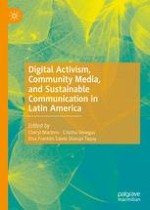2020 | OriginalPaper | Chapter
Indigenous Journalism in Ecuador: An Alternative Worldview
Authors : María Belén Albornoz, Gema Tabares Merino
Published in: Digital Activism, Community Media, and Sustainable Communication in Latin America
Publisher: Springer International Publishing
Activate our intelligent search to find suitable subject content or patents.
Select sections of text to find matching patents with Artificial Intelligence. powered by
Select sections of text to find additional relevant content using AI-assisted search. powered by
